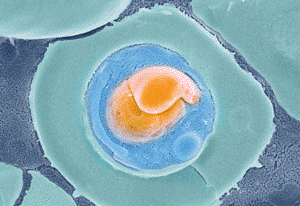Malaria Test Assessed in Nonendemic Setting
By LabMedica International staff writers
Posted on 23 May 2011
A rapid diagnostic test (RDT) for malaria has been evaluated in a standard reference laboratory using stored and fresh blood samples. Posted on 23 May 2011
In nonendemic settings, where microscopic expertise is lacking due to low incidence, malaria RDTs are of value for the diagnosis of malaria and they provide information about the possibly fatal Plasmodium falciparum infections.

Image: Colored scanning electron micrograph (SEM) of a freeze-fractured red blood cell (erythrocyte, green) infected with a Plasmodium falciparum protozoan (orange and blue) (Photo courtesy of the NIBSC).
Scientists at Maastricht University, (Maastricht, The Netherlands), performed both a retrospective study on 341 stored blood samples and prospective study. In the prospective study, the SD Bioline Malaria Ag 05FK40, (SDFK40), RDT was used on 181 fresh samples and run side by side with two other RDTs, OptiMAL and SDFK60. The SDFK40 is a lateral flow antigen-detection test in a cassette format, targeting P. falciparum-specific parasite lactate dehydrogenase (Pf-pLDH) and pan-Plasmodium LDH, (pan-pLDH). The prospective part was performed between March 2009 and October 2010, and included first samples of each patient for which microscopy or one of the both routinely used RDTs (OptiMAL and SDFK60) were positive for malaria.
Overall sensitivities for P. falciparum tested retrospectively and prospectively were 67.9% and 78.8%, reaching 100% and 94.6% at parasite densities greater than 1,000/μL. Sensitivity at parasite densities less than 100/μL was 9.1%. Overall sensitivities for P. vivax and P. ovale were 86.7% and 80.0% (retrospectively) and 92.9% and 76.9% (prospectively), reaching 94.7% for both species (retrospective panel) at parasite densities greater than 500/μL. Sensitivity for P. malariae was 21.4%. None of the Plasmodium negative samples in the retrospective panel reacted positive.
The authors concluded that SDFK40 RDT (Standard Diagnostics Inc.; Suwon, Korea), performed exceptionally for P. falciparum samples at high parasite densities as well as for detection of P. vivax and P. ovale at parasite densities greater than 500/μL. The SDFK40 was evaluated as easy to use, with an excellent clearance of the background and clearly visible test lines. Compared to OptiMAL Rapid Malaria test, (Diamed AG; Cressier, Switzerland), and Standard Diagnostics other RDT, called SD Bioline Ag Pf/Pan 05FK60 (SDFK60), SDFK40 showed lower sensitivities for P. falciparum, but better detection of P. ovale. The study was published online on January 12, 2011, in the Malaria Journal.
Related Links:
Maastricht University
Standard Diagnostics Inc.
Diamed AG




 assay.jpg)








